The nuances of growing tomatoes in a greenhouse
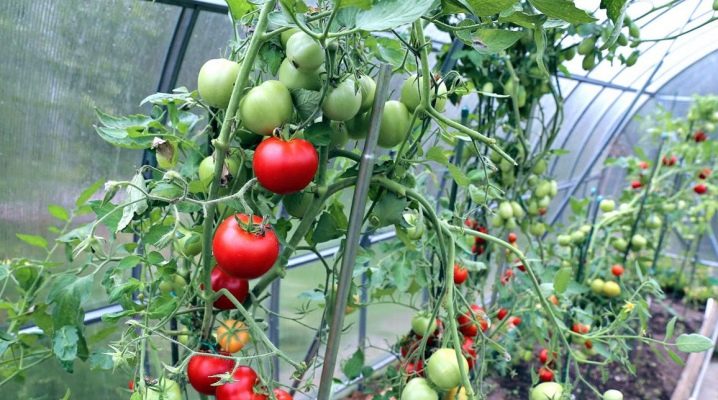
Tomatoes are a favorite vegetable crop in our country. Only potatoes or onions can argue with its popularity. This is easily explained by the high taste of tomato fruits. They contain a lot of useful substances, including a valuable antioxidant - lycopene. It not only stops the aging of cells, but also accelerates their renewal, and also prevents the development of cancers. Not surprisingly, tomatoes are grown all over the place.

Advantages and disadvantages
But a vegetable that is useful and beloved by many gardeners does not grow everywhere in the open field. Culture feels best in warmth and light. Therefore, in colder climates, cultivation of tomatoes in a greenhouse is practiced. To ensure a good harvest, you need to study the features of caring for tomatoes.
Greenhouse cultivation has undeniable advantages:
- the harvest will be able to be harvested earlier, because they are planted in the greenhouse already in April;
- in the greenhouse, plants are protected from precipitation and the scorching sun, as well as from the attack of pests;
- greenhouse tomatoes can be stored for a longer period.
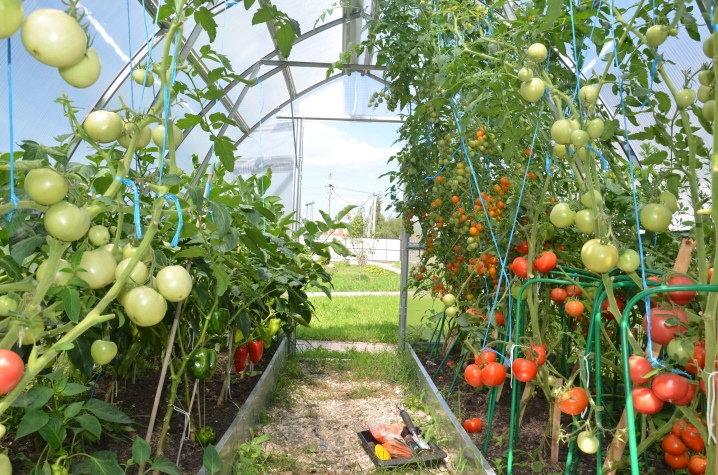
The tomato greenhouse can be equipped with different materials. Each design has features in the form of advantages and disadvantages. As practice shows, tomatoes feel best in spacious, bright rooms.
The conditions in a polycarbonate greenhouse are most suitable for this. Walls made of this material allow light and heat to pass inside in sufficient quantities and serve for more than one season. It is optimal if the greenhouse frame is made of aluminum, as it is lightweight and does not corrode.

Suitable varieties of tomatoes
Tomatoes of determinate (short) and indeterminate (tall) early varieties are suitable for growing in a greenhouse. The market offers seeds of a huge number of varieties and hybrids.
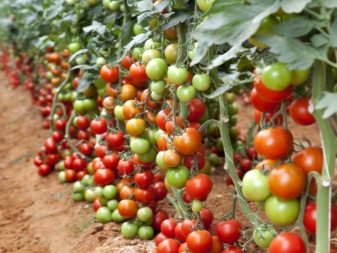
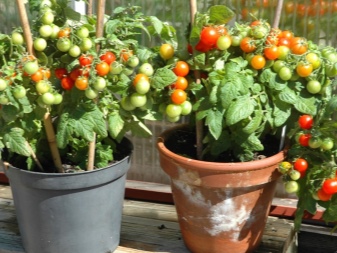
When choosing a variety suitable for a greenhouse, you should pay attention to such a feature as self-pollination. In order not to miscalculate, you should prefer something from the F1 hybrids.
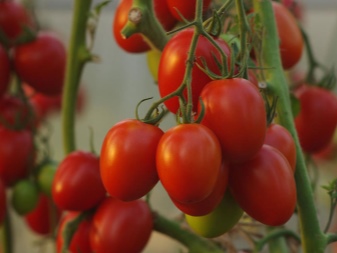

With regard to other characteristics - ripening time, resistance to diseases and pests, color, size and taste - everyone is free to choose what he considers more appropriate.
Prerequisites and preparation
The greenhouse must be prepared for the spring-summer season. The preparation consists of several stages.
- Cleaning. It is necessary to remove everything that remains from the fall, get rid of old pegs, ropes, and remnants of vegetation.
- Cleaning the greenhouse cover. It is necessary to clean it from contamination with soapy water in order to remove existing pathogens.
- Disinfection. You can destroy the sources of diseases and pests by using a sulfur checker. The soil is treated with liquid fungicides (Fitosporin-M and others).
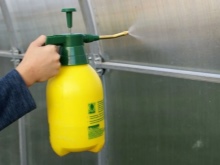
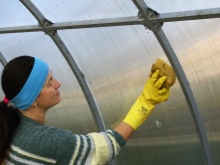

Tomatoes love good lighting and grow successfully in an unheated greenhouse during the warm season. Growers wishing to grow tomatoes year-round should take care of providing a heating system in the greenhouse. Stove heating will be the most economical. With gas heating, it is supposed to constantly ventilate the greenhouse. Electric heating will be the most expensive of all possible types.
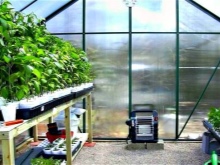
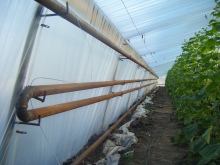
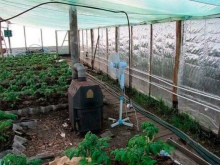
In the daytime, the optimal air temperature for tomatoes in a greenhouse is considered to be 20-25 ° C. At night, these figures should be in the range of 16-18 ° C. When the fruits begin to pour, the temperature should be between 24 and 26 ° C during the day, and 17-18 ° C at night. The parameters of air humidity in the greenhouse must be maintained at the level of 60-65%.
For tomatoes, a soil with suitable acidity is preferred, the composition of which is rich in minerals. The most favorable growth is observed in the black earth and sandy loam land plots.
Stagnation of moisture is detrimental to tomatoes, excessive waterlogging quickly leads to the development of late blight. Therefore, if the groundwater is located close to the site, it is worthwhile to provide high-quality drainage in advance. The soil needs to be loose, soft and light, with good aeration.
In it, before sowing, beds are prepared with furrows 1.5 cm deep, which are abundantly spilled with water. Further, seeds are placed in them, observing a step of 0.8-1 cm. After that, the crops are covered with soil mixture and with the help of a sprayer (so as not to knock the seeds out of the garden) the crops are moistened.
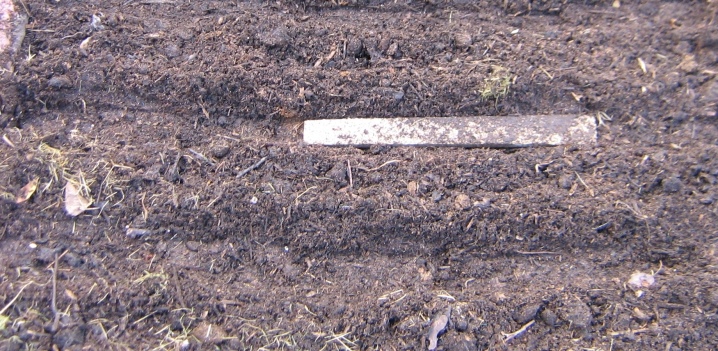
Sowing seedlings
Seeds for seedlings can be divided into two groups: granular (in a nutritious shell) and ordinary, without pretreatment. The first type of seeds does not require soaking, they are suitable for spot sowing, but germination is possible only with regular soil moisture.
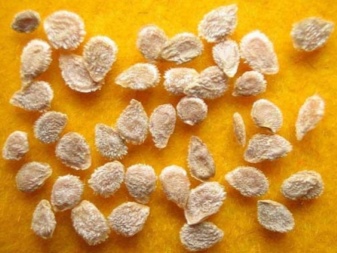

The latter are smaller, but germinate faster. They can be soaked before sowing and treated with fungicides.
Tomato seeds are sown for seedlings from February to March. At home, tomato seedlings are sown in boxes with expanded clay at the bottom. The box is filled with soil and the sowing is watered with warm water.
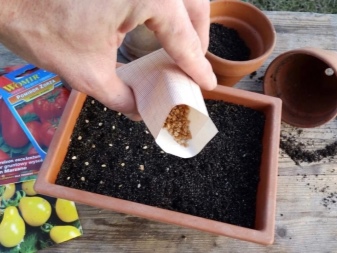
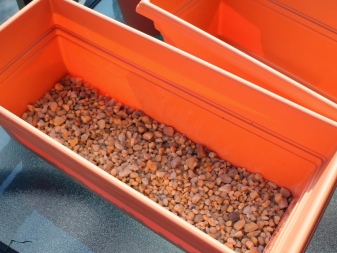
To simplify planting in rows, you can outline grooves 1.5 cm deep. Seeds are placed in them and sprinkled with dry soil mixture, then gently watered from a spray bottle.
Boxes with future tomatoes are removed under a film in a warm place, protected from being blown by the winds. As soon as shoots appear, you can periodically arrange light airing in the greenhouse to harden the plants. It is important to gradually accustom the tomatoes to their normal habitat.
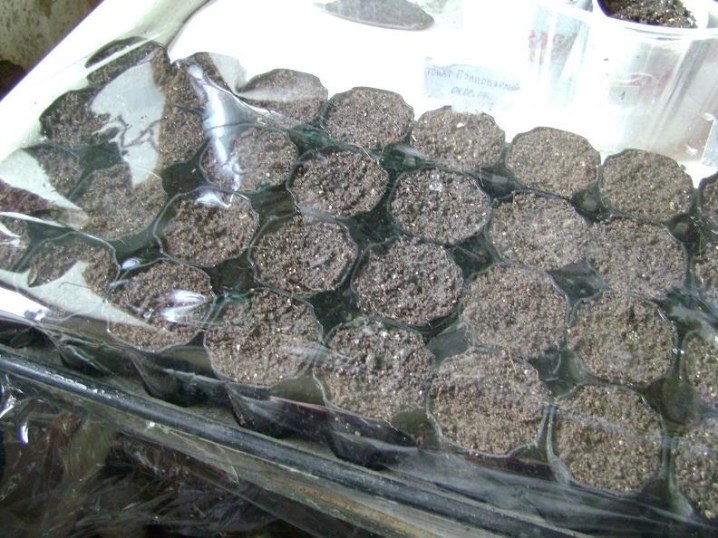
They start picking seedlings after the appearance of two or three leaves. It is transplanted in separate pots or in boxes, observing a large step.
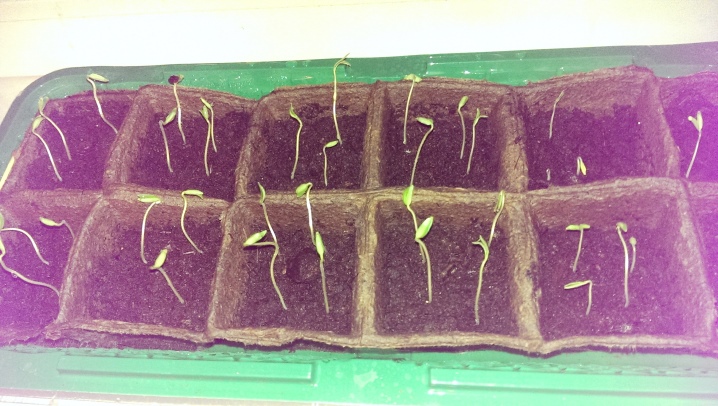
Landing in a permanent place
The grown seedlings are planted in the greenhouse from 1 to 10 May. The greenhouse is covered with a double layer of foil. Leave a 2–3 cm gap between the layers. Such a coating helps to improve the thermal regime and prolongs the preservation of the lower film until late autumn. The second film layer is removed in early June.
With the appearance of the first shoots, all attention will have to be directed to ensuring that the soil remains moist. From time to time you need to arrange airing in the greenhouse with seedlings.
It is best to ventilate after watering so that the difference in humidity and temperature does not affect the turgor of tomato leaves.
When the tomatoes stretch up 20-25 cm, they should be transplanted at a greater distance from each other in their permanent habitat, in an equipped greenhouse. The average distance between them should be from 40 cm. This will allow the tomatoes to actively develop in the root and aerial parts. Landing is carried out at a depth of 25-30 cm.
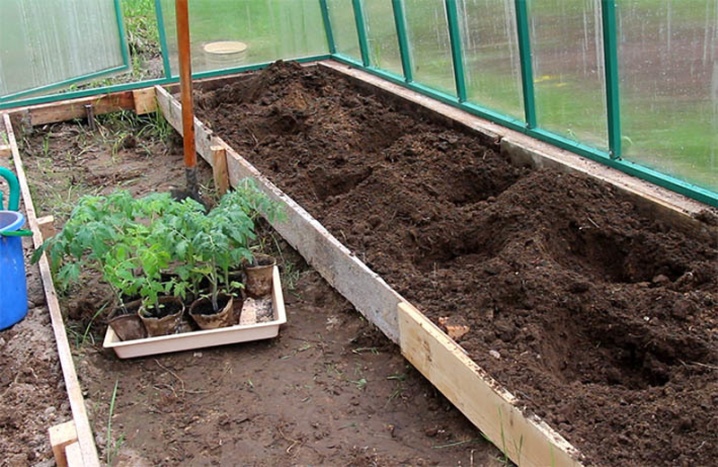
After transplanting the seedlings, it is watered. To improve air exchange the next day, the root areas will have to be loosened.
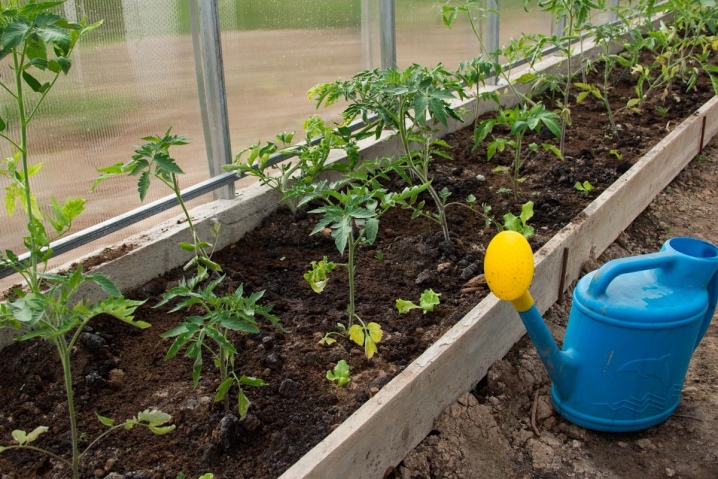
Near what can you grow?
In one greenhouse, tomatoes will not get along with every crop. For example, you should not grow cucumbers nearby, since tomatoes require more frequent ventilation, lower humidity and ambient temperature.
If you still have to grow these vegetables in the same covered area, you will have to block the zones for each type of plants with foil.
The best compatibility of tomatoes with pumpkin, carrots, radishes, garlic, beets, celery, radish. Tomatoes are also friends with cabbage: cauliflower, Brussels sprouts, white cabbage and Peking cabbage.
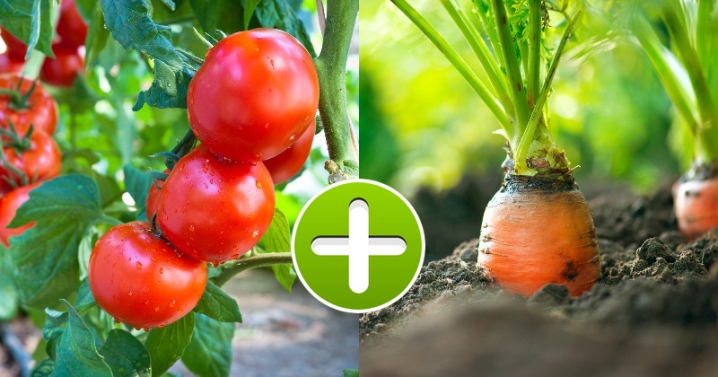
Tomatoes respond favorably to mint, lemon balm, basil and borage. Fragrant greens repel pests and only benefit tomatoes of different varieties.
Tomatoes grow well and nearby with salads, celery, asparagus, parsley, as well as spinach and sorrel. But it is advisable to avoid "closeness" with dill. Peas and eggplants are also not very good "friends" on the site for representatives of nightshades. As for the most unfortunate neighbors, these include potatoes and corn.
The beds can be "diluted" with planting garlic and onions. In addition to being an excellent company for tomatoes, they also disinfect the air with phytoncides, protecting their neighbors from the dangerous phytophthora.
Also useful for tomatoes will be their neighborhood on the same territory with berry bushes - currants and gooseberries. These bushes will drive away moth and sawfly from tomato plantings. And the bird cherry planted nearby to them scares off the scoop.

It will be interesting to combine planting tomatoes and early varieties of strawberries. In this case, it will be possible to save space and get a berry and vegetable harvest from one garden bed.
Care
To get a large harvest of greenhouse tomatoes without depleting the soil, it is necessary to carry out agrotechnics correctly. These recommendations will be useful for novice agronomists.
You need to mulch actively, using fresh cut grass, straw or sawdust. Mulch will also act as an organic fertilizer.
In the fall, after the dried tomato plants have been removed, you need to dig up the beds along with the mulch. This will naturally enrich the soil with organic matter. You will need to re-decompose the organic mulch before winter.
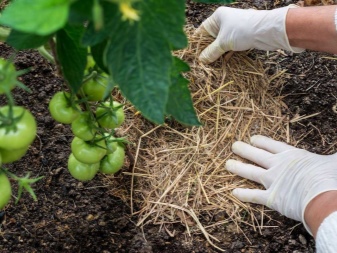
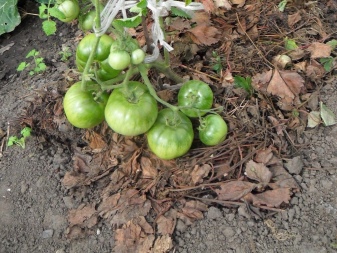
Watering
After the seedlings are planted in the greenhouse, it is important to monitor the soil moisture and provide the plants with water in a timely manner. So they can actively develop and receive a good supply of the necessary nutritional elements. After 7-10 days after planting, the first watering is performed, then you need to water it once with an interval of 5-6 days.
The interval between waterings depends on the humidity and temperature in the greenhouse. Here, for each gardener, everything happens individually, without observing the exact rule for calculating days.
It is important to water the tomatoes at the root, being careful not to get water on the green leaves. The next day after watering, it will be useful to loosen the root zone. This contributes to better aeration of the soil and prevents possible stagnation of water.
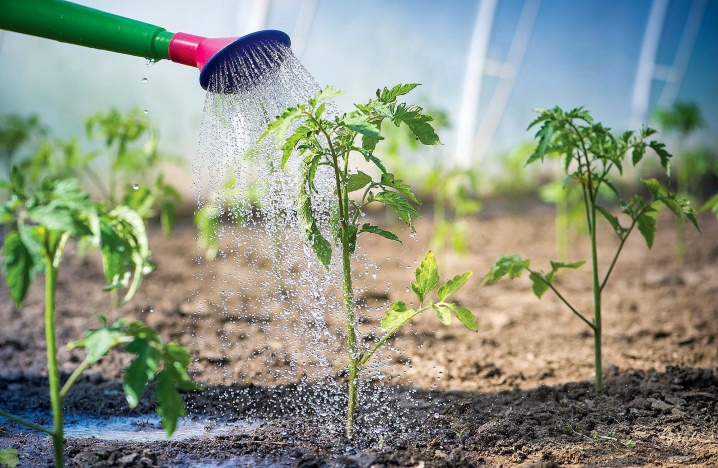
In greenhouses, it makes sense to use a drip irrigation system if the tomatoes are grown in large areas. The essence of this method of irrigation is that moisture is delivered directly to the roots, preventing moisture from the aerial part. At the same time, water is supplied in a metered dose, gradually penetrating directly to the roots of plants.
The greatest advantage of drip irrigation technology is that it maintains a fertile soil layer and reduces nutrient loss. The drip irrigation system in the form of hoses with holes is laid even before planting.
For watering nightshades in a polycarbonate greenhouse, you can purchase a ready-made drip irrigation device or make it yourself.
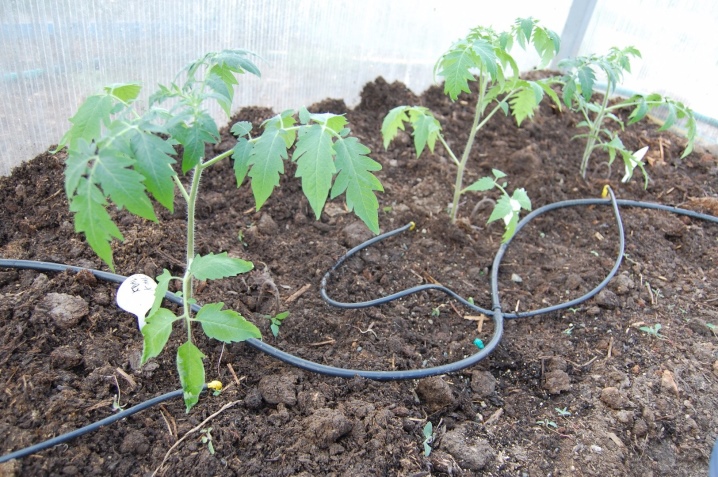
Top dressing
Fertilize young plants two weeks after they have been planted. Further, the nightshade culture should be fed with the appearance of the first flowers, and then - in the phase of fruit formation.
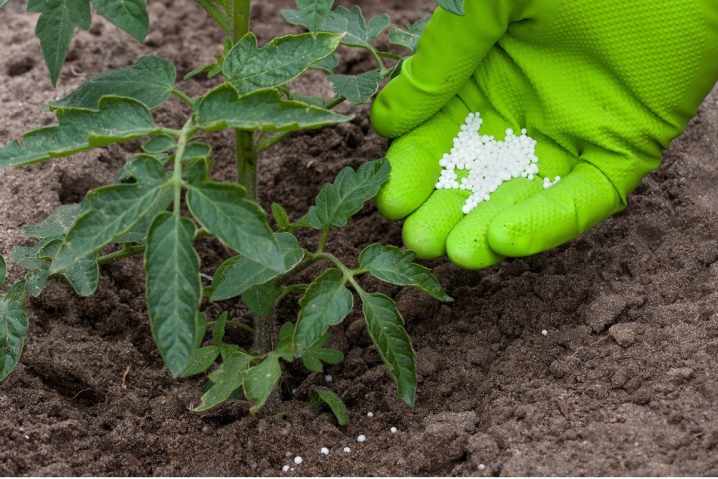
The best fertilizer is superphosphate and potassium humate.
Stepping
Superfluous stepchildren on the stem of tomatoes partially take over the plant's nutrients, taking away its strength.
Tomatoes are formed into one stem. You need to save up to 7-8 flower brushes or leave only one lower stepson with a single flower brush, and the rest of the stepsons are removed from the deciduous and root sinuses when they reach 8 cm in length.
The primary removal of stepchildren is carried out when they appear, even on seedlings. Branches grow especially actively after the seedlings are planted in the greenhouse. Therefore, they will have to be cut approximately once every week for the entire growing season.
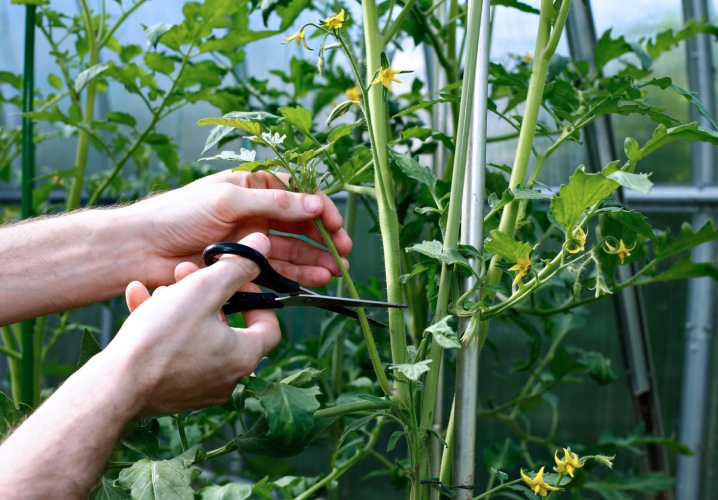
Both leaves and side shoots are best removed by hand. Insufficiently sterile equipment can cause great harm to the plant.
Airing
A greenhouse intended for tomatoes must be equipped with vents. They are made not only on each side, but also 1-2 vents on top. Thus, tomatoes, especially in the flowering phase, can be adequately ventilated.
In a closed greenhouse on hot days, the temperature rises quickly and the plants "burn". At the same time, pollen is sterilized and you can no longer count on full development. Airing is especially important during the flowering period. At this stage in the development of nightshades, it is necessary to prevent the appearance of condensation on the film.

The greenhouse must be ventilated regularly and frequently. As soon as the temperature settles, the film is removed before the onset of autumn.
Garter
With a timely garter of seedlings, it will be possible to keep the bush intact. The presence of support will not allow heavy ovaries and fruits to deform and crumble. Pegs that are 5-10 cm higher than the plants serve as a garter. Cords or strong fabric tape (s) are also needed. They attach the plant to the support.
The peg is installed directly upon landing in a permanent place. It is located parallel to the trunk so as not to injure the roots. The trunk is tied to a peg.
The garter is continued as the plant grows. The largest branches with fruits are also tied to the peg. This approach prevents tomato deformation and shedding.
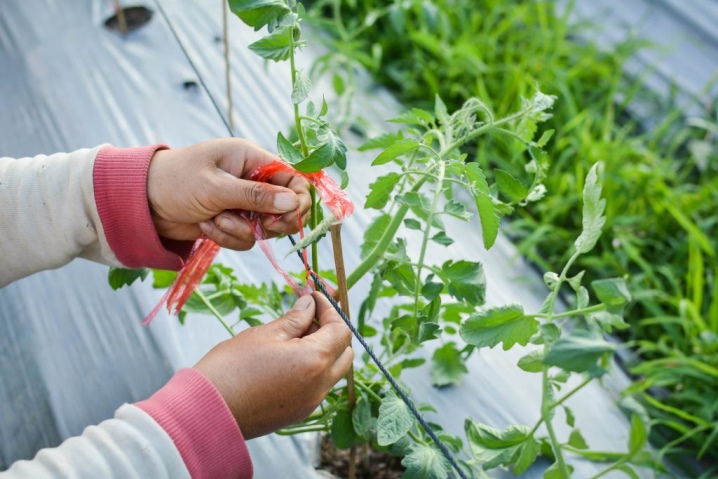
Diseases and pests
One of the most important steps in caring for growing tomatoes is protection from pests and pathogens. The greatest danger and serious harm to tomatoes is late blight. This is a fungal disease, which often makes itself felt with sudden changes in temperature, increased humidity or thickening of the plantings.

At the initial stage of the disease, spraying the seedlings with garlic infusion gives a good therapeutic effect. Spraying with Trichopolum will also help. It is effective to use the biofungicide "Fitolavin" against rot in the greenhouse.

It is important not to let debris and weeds lie on the site.
Another disease that poses a serious threat to the development of tomatoes is Alternaria - the so-called dry spot. The disease can destroy about 85% of the crop. It manifests itself as grayish-brown specks, which tend to actively spread. Plants can be rescued by fungicide treatment and at the same time, watering should be reduced.
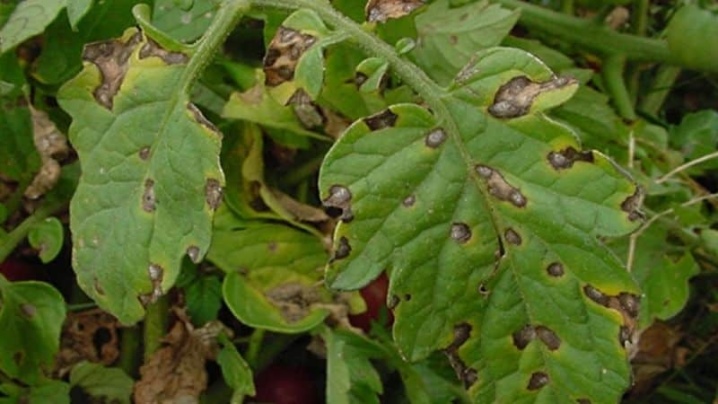
Top rot, which leads to the rapid death of tomatoes, is also considered one of the serious diseases. It develops from a lack of calcium in the soil and with strong temperature changes. In the initial stage of the disease, foliage treatment with 0.2% calcium chloride in liquid form (three times a week) is shown.
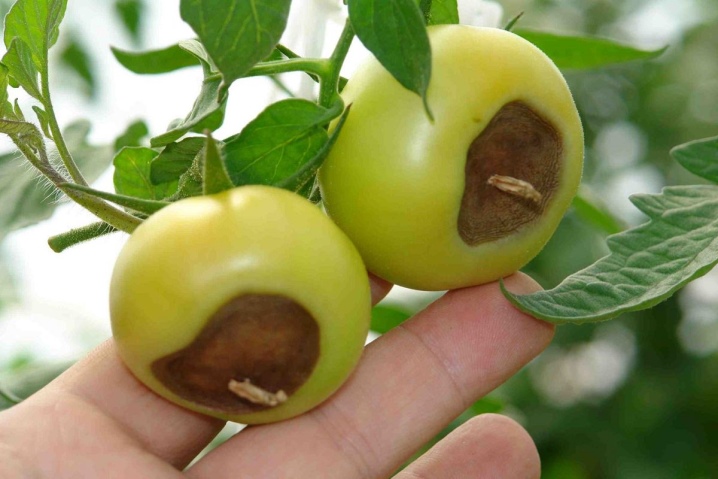
Brown spot can also hit the foliage on tomatoes. The fungal disease passes from the leaves to the ovary and affects the petioles. Spores are quickly transferred to other plants. Under favorable conditions for him, the fungus can destroy up to 30% of plantings.
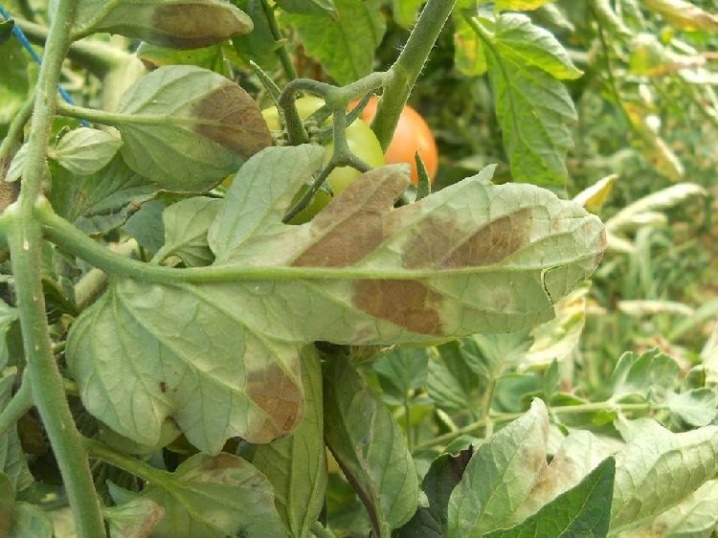
Control measures - treatment of bushes with infusion of garlic, celandine, potassium permanganate. Of the chemicals, we can recommend Antrakol, Consento.
In addition to the listed dangerous diseases, plants can be affected by a mosaic of tomatoes. Its development is indicated by the appearance of yellow spots on the leaves. Sometimes the virus parasitizes the fruit. Mosaic infects plants through seeds or soil. A measure of protection against infection is the treatment of plants with clean tools.
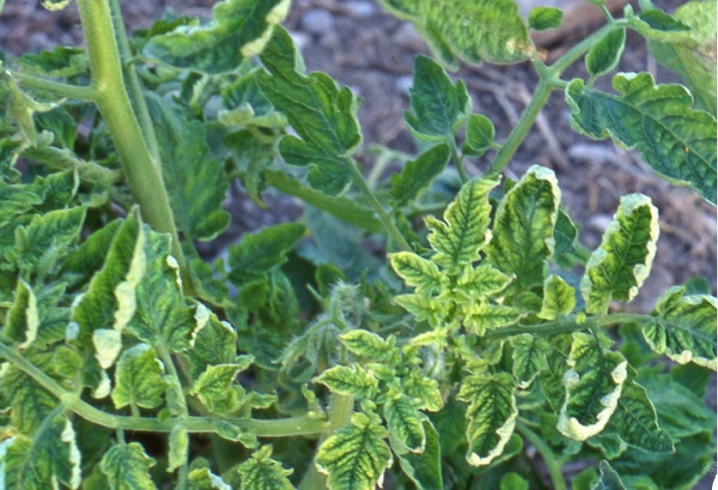
The affected bushes will have to be removed so that other plants on the site do not become infected. It is important to process the place of growth with potassium permanganate.
Sometimes at the stalk, the fruit turns red, but at the top it remains green or at best yellow. The main reason that tomatoes do not turn red is insufficient lighting due to the density of plantings.
Perhaps the reason is also the disturbed temperature regime in the greenhouse or the excess of the sun. If the soil is oversaturated with nitrogen fertilizers or needs potassium, tomatoes will also signal insufficient redness of the skin.
An equally important problem is that tomatoes are not tied. Probably the reason is inappropriate air temperature. It is necessary to maintain it at a level of + 15-28 degrees. Not higher or lower than these indicators.
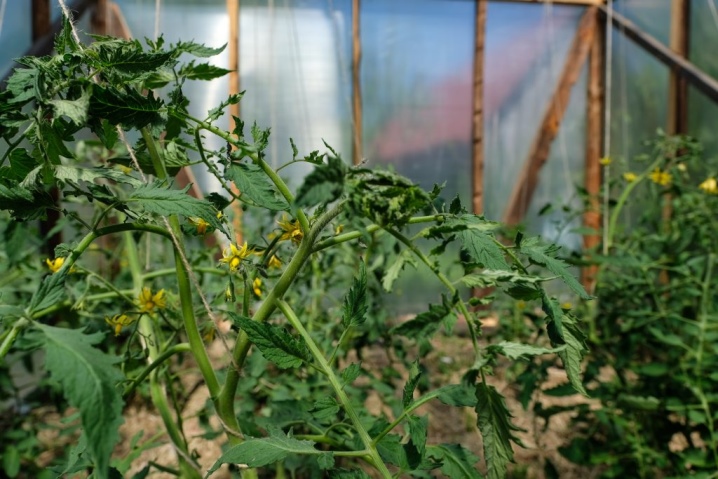
When the leaves are curled at the top of the plants, wood ash should be used. The ground under the bushes is loosened and up to 70 g of ash is poured into it. The use of potassium sulfate also solves the problem.

Another problem that worries agronomists is the appearance of small fruits. This may be due to non-observance of the temperature regime and air humidity, insufficient watering, and lack of nutrients.
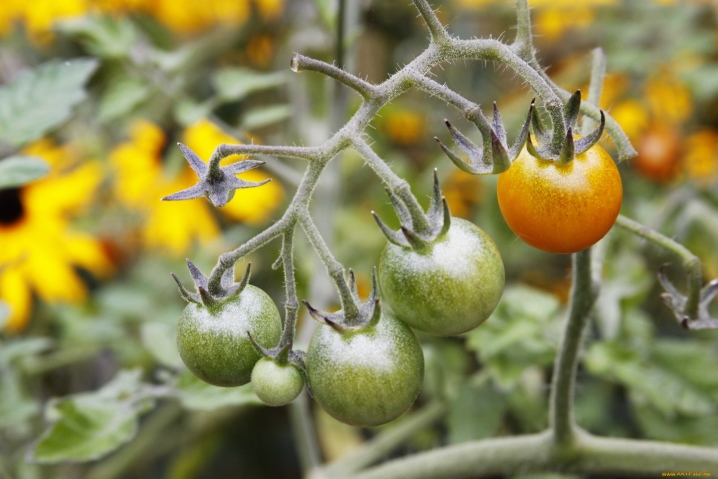
If the fruits of tomatoes are cracking, this is a sure indicator of improper watering and an excess of nitrogen in the nutrient mixtures that are used for feeding.
Productivity and harvesting
When growing tomatoes in a greenhouse, the yield increases, many times exceeding the results obtained in the open field. On average, in a greenhouse it is possible to collect from a bush up to 1.5-2 kg and from 20 to 28 kg of tomatoes from 1 square meter.
To obtain a high-quality and generous harvest in greenhouse conditions, plentifully fruiting tomatoes of indeterminate varieties are usually chosen. It is important for the tomatoes to provide enough space for food. The ripening time depends on the characteristics of the variety, climatic conditions, adherence to proper agricultural technology and the condition of the seedlings.
Tomatoes in the greenhouse are protected from adverse influences from the outside, so there is no need to rush to pick tomatoes at the stage of milk maturity. At the end of summer in the greenhouse, the fruits can ripen directly on the bushes. Only new ovaries should be removed, since they will not ripen anyway. Ripe tomatoes are removed as early as possible, stimulating the emergence of new fruits.
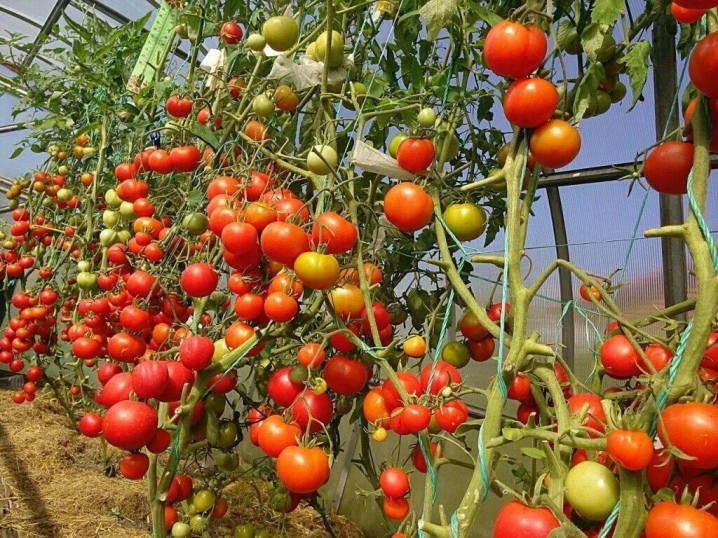
Gardening tips
Tomatoes may not grow well in hot weather. They need to be shaded from the strong sun. One of the secrets of experienced gardeners is the application of chalk or lime mortar to the walls and ceiling of the greenhouse. In the future, it is easy to wash off, and the tomatoes will be in the shade.
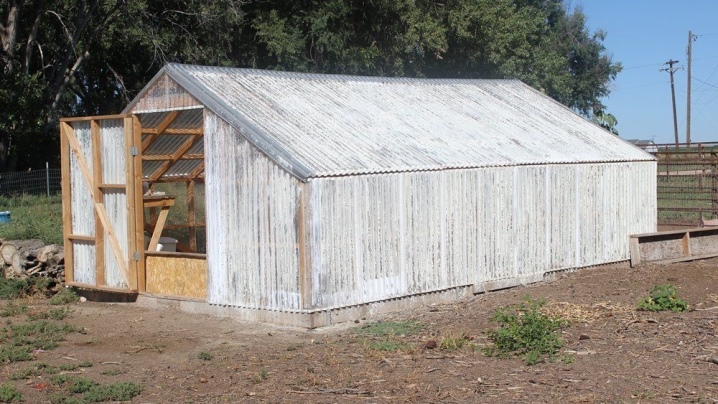
Before planting in the spring, it is recommended to spill the soil in the greenhouse with a solution of potassium permanganate.
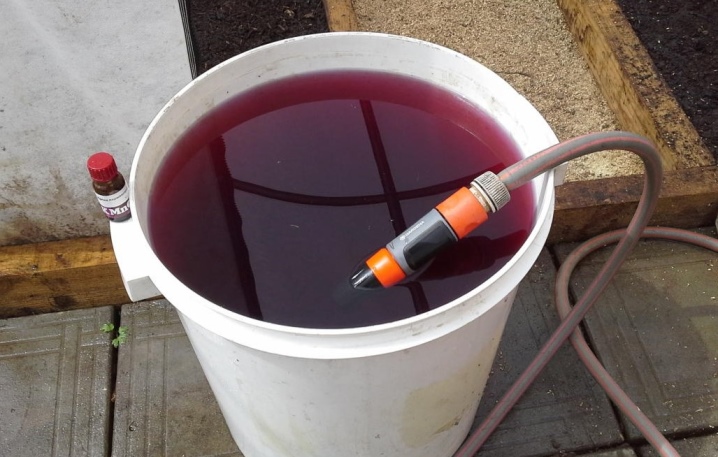
According to gardeners, it is best to grow productive hybrid varieties in a greenhouse. They can be stored for a long time and are resistant to infestation and pests.
Tomatoes in a greenhouse give a more bountiful harvest compared to growing outdoors. But for this they need proper care, worth a lot of effort.
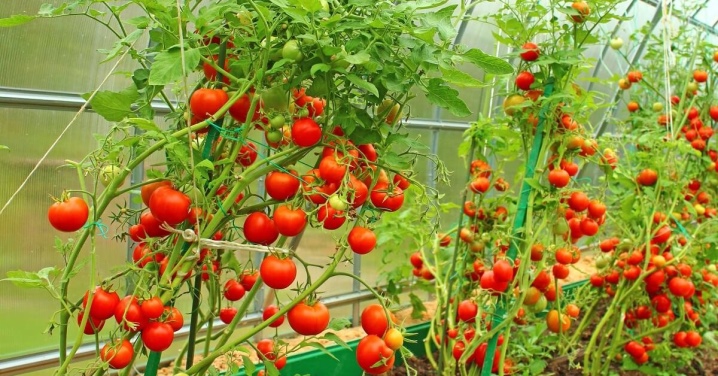











The comment was sent successfully.